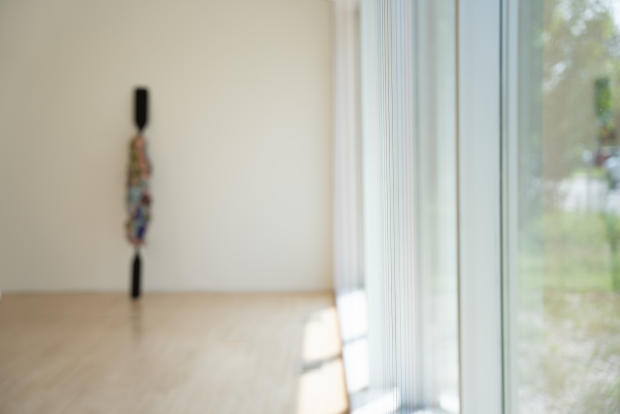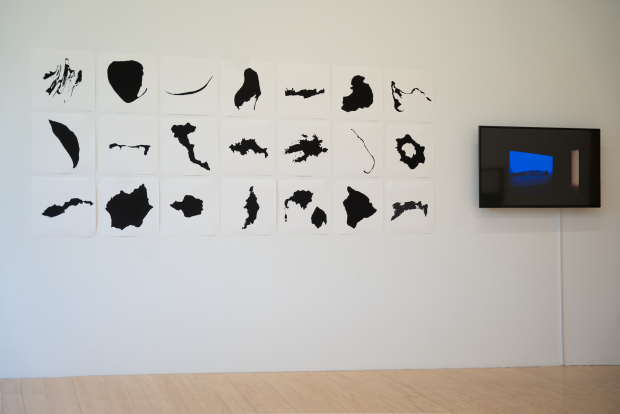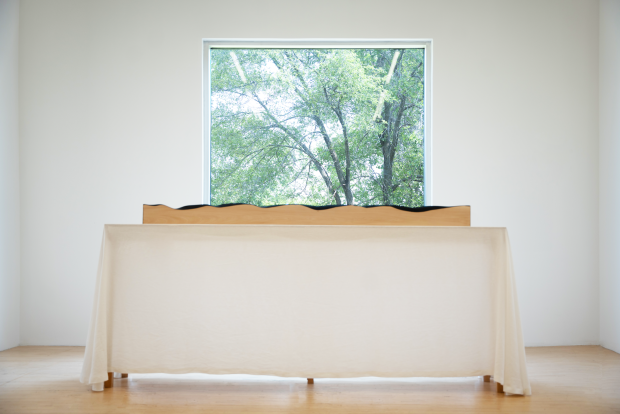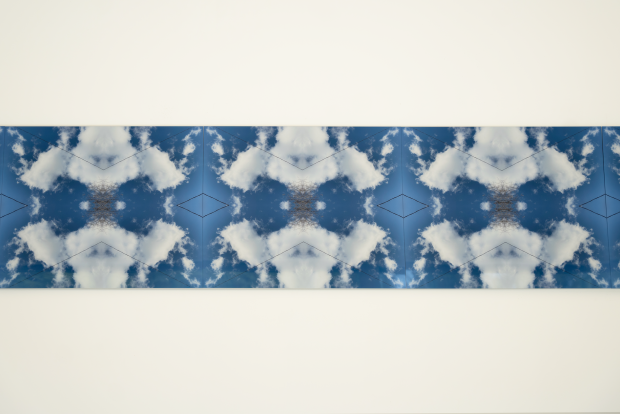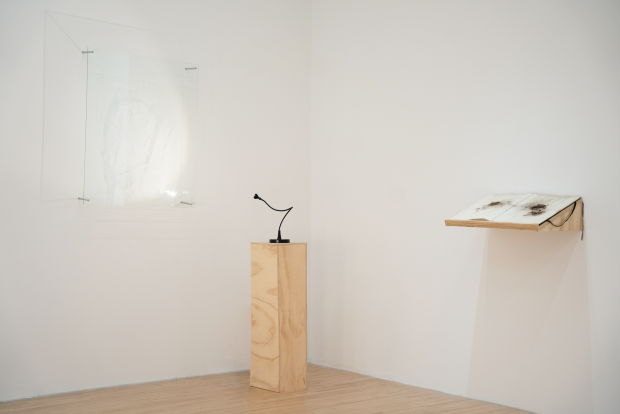
Crédit photo : François Chalifour et Richard Gagnier.
Atlas de nostalgie
Exposition collective
- Exhibition
Presented as part of the centre's summer programming, the exhibition Atlas of Nostalgia takes place in all three rooms of AXENÉO7.
Opening night: July 3, 2024, 6pm to midnight.
Dj set: Rodrigo Medrano / Dj Parfois
Free admission
Food: Chloé Berlanga — Upon donation
Bar on donation
Free parking
“Nostos” means return; nostalgia is the ache of return.
François Chalifour's writing practice serves as the common thread that unites the artists of the exhibition Atlas de nostalgie [Atlas of Nostalgia]. The three curators - Richard Gagnier, Jonathan Demers and François Chalifour - find themselves in both familiar and new territory. They have chosen to articulate the exhibition around a narrative geography subdivided into three spaces (topos) linked by the theme of nostalgia: the eternal return; the clues of nostalgia; the quest, the journey, the adventure.
Through its constant anticipation of return, Nostalgia contains the remedy for its ailment, the return itself, even if indefinitely deferred. Eternal return concerns everything related to the very essence of nostalgia: the place of origin coordinated with the time of absence. It's also about departures constantly postponed, crossings always thwarted, and arrivals long delayed. The island is a paradigm of this original topos: Ithaca, this arid, rough, isolated land, is for Ulysses a kingdom of gentleness and peace.
At first glance, nostalgia is a spatial, geographical concept. It implies the physical distance separating the wandering soul from its place of origin, the object of a persistent desire. Obvious figures of nostalgia would be exiles, emigrants and travellers.
Yet there is no distance without time. Physical distance implies the unfolding of time. And time gnaws, erodes and flattens. This is why clues to nostalgia are scattered like recurring symptoms* revealing a latent operative force. Seeing a ruin, for example, points unmistakably to the temple that precedes it.
The ruin serves merely as a conceptual model for nostalgia since it lies somewhere on the axis that separates the temple from its eventual ashes. Ruin can thus be the sign of definitive obliteration engendering melancholy, but it can, on the other hand, appear as the blueprint for a temple to be built, or rebuilt.
In between, there is inevitably the quest, the journey, the adventure. There can be no nostalgia without departure. You have to leave your country, land and loved ones for nostalgia to take hold. Wandering is the imperative condition for nostalgia. In this sense, it provokes a desire to return, leading to a quest for origins, a necessary voyage and the adventures that follow. Once the raft is built, all that remains is to leave the island, cross the sea and brave the storms.
*Aby Warburg, 1896 - 1929
— François Chalifour
Commissaires
François Chalifour
François Chalifour works in the fields of painting, drawing and multidisciplinary installation. He has been a professor at Cégep de l'Outaouais, Université du Québec en Outaouais and Université du Québec à Montréal. A doctor in semiology, he has contributed to the cultural magazines Vie des arts, Espace sculpture and Espace Art Actuel, Liaison and the international semiotics journal Visio, among others. He was a member for 15 years and president for 8 years of the Board of Directors at AXENÉO7 artist-run centre in Gatineau. He was also a member and co-president of the Canadian Society of Aesthetics for 14 years. In 2010, he founded the Groupe Hécate with Diane Génier (1956 - 2015), a group dedicated to exploring drawing in all its forms, which ran until 2015.
Jonathan Demers
Jonathan Demers completed his Bachelor's and Master's degrees at UQAM's art history department from 2001 to 2008. He was director of AXENÉO7 artist-run centre in Hull from 2008 to 2014, before taking up his current position as executive director and head of conservation at the Musée d'art contemporain des Laurentides (MAC LAU). He has also helped set up collaborative initiatives such as the Complot project and HB magazine. He has collaborated with several artist-run centres and institutions, and taught art history at the Cégep de l'Outaouais. He has curated several projects, including Amour Anarchie and Les Salons at AXENÉO7, Numa Amun's exhibition Raccord at MNBAQ (2019) and Quand la collection prédit l'avenir at MAC LAU (2019 - 2024).
Richard Gagnier
Richard Gagnier has been Head of Conservation at the Montreal Museum of Fine Arts since 2007. His practice focuses on the restoration-conservation of contemporary art. He was a member of the research group of the DOCAM alliance (2005-2010), and of a team led by Francine Couture concerned with the re-exhibition of contemporary art (2003-2012).
Concurrently, he acts as an independent curator, in particular with AXENÉO7 artist-run centre, of which he was a member of the Board of Directors for over 15 years (1987-2005). In recent years, he has conceived In collabo Hadès, interweaving the collaborative works of François Chalifour, Marc Audette and Diane Génier (2015), a monographic project with Marie-Claude Bouthillier (2018); Cartes sur table, at the Musée d'art contemporain des Laurentides; and an exhibition of works by Lisette Lemieux, Consonance, at the Fondation Molinari (2019).
He was a member of the board of directors of the Artexte documentation centre for 9 years (2009-2018), including 4 years as president.
Artistes
Hannah Claus
A Kanien'kehá:ka and English artist, Hannah Claus explores Kanien'kéhá:ka ontology as material and sensory relationships in her artistic practice. Elected to the Eiteljorg Contemporary Art Fellowship in 2019 and recipient of the Prix Giverny 2020, her works are held in various public collections, including the National Gallery of Canada and the Montreal Museum of Fine Arts, among others. Claus lives in Tiohtià:ke | Montréal and is a member of the Kenhtè:ke | Tyendinaga community.
Daniel Corbeil
Daniel Corbeil, a native of Abitibi-Témiscamingue, raises highly topical questions about the effects of climate change on the landscape. His retro-futuristic constructions pose the limits of contemporary architecture and engineering on the environment.
His works are part of various public and museum collections. In 2018, Éditions Plein sud and the MA Musée d'art de Rouyn-Noranda devoted a monograph to his work over the past twenty years.
Josée Dubeau
Josée Dubeau takes a critical look at modern architecture and furniture design, and more recently at linear perspective. For her, the resulting orthogonality determines our everyday relationship with space.
Josée Dubeau's career is punctuated by international residencies. Josée Dubeau taught drawing and sculpture at the University of Ottawa and UQO for 15 years. Her work can be found in numerous collections in Quebec, Canada and Europe.
Mathieu Gaudet
Mathieu Gaudet's sculpture, often imbued with paint, raises the paradoxical relationship between the vision he assumes to be two-dimensional and the three-dimensional reality of the physical object. This observation sets him off on exploring the links between surface and depth, as much as between colour and matter.
Mathieu Gaudet hails from the Laurentians. After studying at Concordia University, an extended stay in New York had a decisive effect on his practice. His work has been exhibited in Quebec, Canada, France and Japan.
Diane Génier
Diane Génier developed drawing techniques and materials: paper, projection, shadow, installation, video, new media, virtual space, fire and flame. Her practice explored personal space, examining the recuperative element in the uniqueness of the gaze. Her latest works explore the relationship between the construction and reading of the image and memory as a place of archiving, source and structure of gesture and trace.
Diane Génier was a founding member of AXENÉ07 artist-run centre (1982) and of DAÏMON photo-video-new media production center (1986). Alongside her artistic career, she pursued a career in arts administration, directing and managing exhibition programs and activities.
Diane Génier died on May 31, 2015 of cancer; throughout her illness, she worked on her artistic production, mainly with Groupe Hécate, founded in 2010 by François Chalifour. (F.C.)
Jérôme Havre
Jérôme Havre's work is inspired by natural history dioramas in museums and zoos. His work addresses questions of identity, territory and community in the representation and perception of nature through our cultural filters.
He has received several grants from the Canada Council for the Arts, the Conseil des arts du Québec, the Ontario Arts Council and the Toronto Arts Council. Since 2001, he has exhibited his work in Europe, Africa and North America.
Catherine Lescarbeau
Catherine Lescarbeau is interested in the relationship between conceptual art and institutional critique, and the relevance of these approaches today. In her installations, she uses simple objects from colonial industrial expansion to explore the relationship between culture and nature within corporate and institutional spaces.
Catherine Lescarbeau is pursuing doctoral studies in Études et pratiques des arts at the Université du Québec à Montréal. She has participated in several solo and group exhibitions in Quebec and France.
Ed Pien
Ed Pien's work explores time, the sensibility of nature, memory, the representation of trauma, resilience and empathy.
Taiwanese-Canadian artist Ed Pien holds an Honours BFA from the University of Western Ontario and an MFA from York University. He exhibited numerous times in Ottawa, New York and London, among other places. He has participated in biennales in Montreal, Sydney, Moscow, Beijing, Curitiba and Asunción.
I would like to thank all the Elders participating in this ongoing project in San Agustín, Cuba, including Eidy Rosa Marrero.
To be thanked are also Catherine Sicot, Curator and Producer for this Cuba project.
Also editors: Vlad Lunin, Nestor Siré, Juan Manuel Perez and Johannes Zits.
Jean-Yves Vigneau
Born on the Îles-de-la Madeleine, Jean-Yves Vigneau has cultivated emotional and aesthetic ties with the maritime landscape and culture. He has translated this attachment into sculptures, installations, drawings, photographs and videos.
Jean-Yves Vigneau has produced about thirty public works, presented numerous solo exhibitions and participated in many art events in Quebec, Canada, Brazil, Europe and the United States. He has been associated with the Regroupement des centers d'artistes autogérés du Québec and the artist-run centres AXENÉO7, DAÏMÔN and AdMare.
